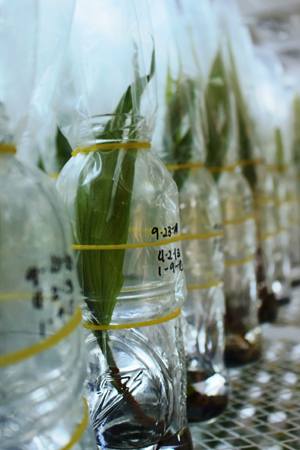“Makapuno” is a Filipino vernacular loosely translated as “almost full”. Conversely, when one speaks of makapuno it refers to a mutant coconut because of its genetic abnormality; and it is characterized by its soft endosperm and by how much it fills the nut.
The makapuno phenomenon is believed to be governed by a single recessive factor and the palm which occasionally bears makapuno nuts is heterogeneous for the character. These coconuts which do not germinate in situ, have normal embryos which can be extracted and cultured in vitro where they will germinate normally to give rise to palms with high makapuno coconut yields. The makapuno industry however, is just a small portion of the whole coconut industry. Area planted is only 577 hectares while area planted to coconut is 3.56 million hectares. (Batalon, 2009).

The increasing demand for makapuno meat as the main ingredient in many food products like sweets, candies, desserts and ice cream, and its use in non-food products like cosmetic lines, lotions and soaps, has led farmers, private investors and entrepreneurs interested in this crop, and thus becoming a lucrative business.
The Makapuno Road Map 2010 prepared by the Department of Science and Technology (DOST), indicated that the total demand for makapuno meat is estimated at 4,209,732 kilograms per year against total production of only 215,202 kilograms per year. The gap of roughly 3.9 million kilograms per year will require 7,900,000 nuts. A total of 800 hectares have to be planted to address the said gap and to ensure stable supply.
In a published report prepared by Dr. Erlinda Rillo of the Philippine Coconut Authority (PCA) in Albay, recommended that in order to meet such demand an estimated 133,151 Embryo-Cultured Makapuno (ECM) seedlings are needed to develop the competitiveness of the food and non-food products, and the only way to mass produce makapuno is through embryo culture, which was believed to be developed by the late Dr. Emerita V. de Guzman of UP Los Baños in 1960. ECM involves the excising of the embryo and growing it in a culture medium permits the successful development of seedlings from makapuno nuts.
Increasing ECM production
To boost the production of makapuno in the countryside, the Department of Agriculture – Regional Field Office IVA (DA-RFO-4A) through the Southern Tagalog Integrated Agricultural Research Center (STIARC), responded to the challenge by increasing ECM production through a project, “Productivity Enhancement and Development of Makapuno-based Products” which was funded through the National Technology Commercialization Program (NTCP) of the Bureau of Agricultural Research (BAR).
The objectives of the project were to 1) increase the production of ECM through improved package of technology and develop makapuno-based-products; 2) improve the existing tissue culture laboratory and processing room; 3) maintain the existing one hectare makapuno demo; and 4) produce 2,000 germinated ECM at the end of two years. The project was conceptualized in June 2010 and was completed in 2013.
Project proponents led by Ms. Digna Narvacan, STIARC manager, together with Daisynette Manalo, Cynthia Leycano and Fe Lupig, reported that production of ECM planting materials was done in the station’s laboratory which would become the source of quality planting materials for makapuno not only in the Batangas province, but also in other neighboring provinces in Region IV and in other regions as well. The laboratory protocols were also modified resulting in an increased production of ECM from 60 to 89 percent. The mortality rate likewise dropped from 40 to 11 percent. Further, as the result of the technical and financial assistance provided by DA-BAR, total nuts harvested increased by 443 percent.
Project impact
With the modified protocol, which is a result of the project, the in vitro culture was shortened from 14 months to 10 months. The cost of production was also reduced by as much as 20 percent. Since the project started in December 2010, a total of 7,748 nuts were harvested, of which 6,819 embryos were recovered. Twelve percent of the embryos were either non-makapuno, aborted or damaged during excision. However, there was an improvement in the percentage embryo germinated from the total embryo recovered from year 1-3. As of May 2013, there were 5,135 ECM planting materials (different stages) produced at STIARC.
In terms of product development, the project developed three food products from makapuno (makapuno strings, balls, powder) and one non-food product (makapuno soap).
The adoption of embryo cultured technology is an example of successful technology dissemination. It is a technology that has been optimized and successfully adopted. The dissemination and demonstration of this technology, through the project, has resulted in the high demand for these ECM materials. Proponents concluded that ECM production is feasible and economically viable, and therefore highly recommended for farmers’ adoption. ### (Patrick A. Lesaca, DA-BAR)
———-
References:
1. Batalon, 2009. Makapuno Industry Situation. Paper presented during the Makapuno Road Mapping, DOST-Los Banos, Laguna.
2. Makapuno Road Map. 2010. Philippine Council for Agriculture, Aquatic and Natural Resources Research and Developmen- Department of Science and Technology. Los Baños, Laguna
3. Philippine Coconut Authority-Albay Research Center. The ECM Technology Guide, 2004.
4. Rillo, E. 2005. Technology Dissemination, Demonstration and Adoption of Embryo Cultured Makapuno (ECM) in Regions 4 and 5. Terminal Report.
5. Project Brief of the Productivity Enhancement and Development of Makapuno-Based Products, 2010-2013.
———-
Contact person:
Ms. Digna P. Narvacan
Manager, STIARC
Marawoy, Lipa City, Batangas
email: [email protected]
Source: bar.gov.ph
